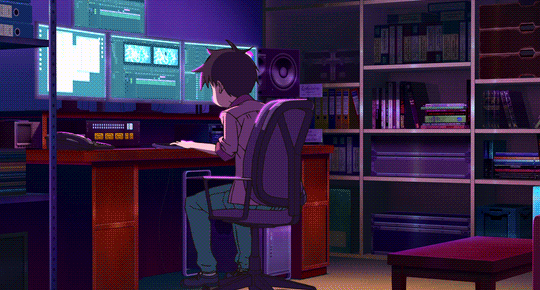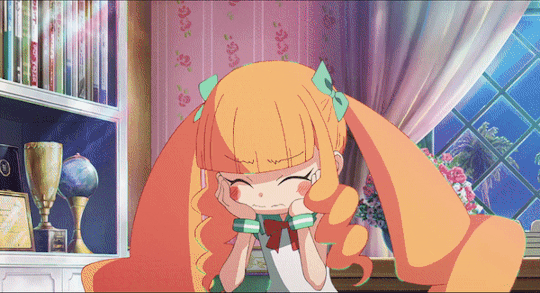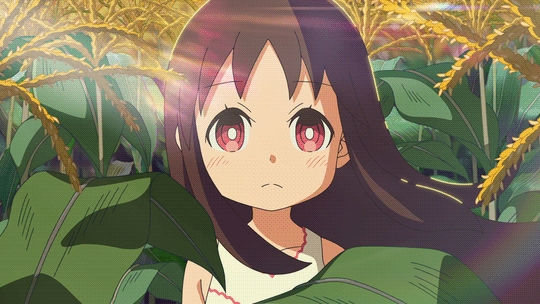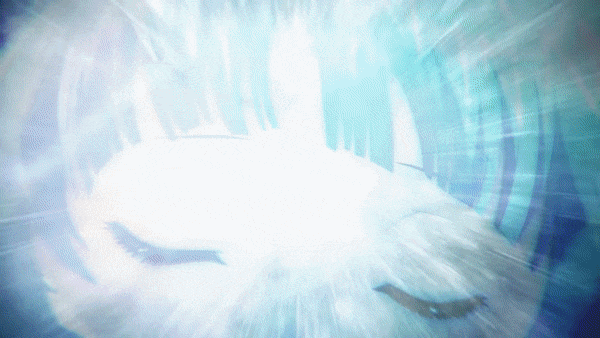originally posted at https://canmom.tumblr.com/post/695499...
Hi friends! Short writeup today since I’m up pretty late.
Happy Animation Night 123! Today to celebrate the theme of ordinal numbers we’re going to be watching Sesame Str-

So! It’s summer (in the Northern hemisphere) so let’s watch some summer movies! I’m not entirely sure how this genre got established - perhaps Makoto Shinkai is to blame - but it’s become a regular thing for anime films to drop in the summer, typically sci-fi-inflected romances, recognisable by a brilliant blue sky filled with fluffy white clouds - often a big cumulonimbus - on their poster.
So tonight we’re going to be checking out two such movies from the last couple of years. One is Pompo, the Cinéphile (映画大好きポンポさん Eiga Daisuki Pomposan) from last year; the other Bubble which dropped a couple of months ago)…
Let’s start with the earlier film, Pompo!

Pompo is a film about an established movie director, Pompo, and two young people: her assistant, a movie buff named Gene, and a young girl Natalie who just arrived in the city with dreams of becoming a movie star. In the story, Pompo gives Gene the chance to direct one of her scripts, and he takes it maybe a little too seriously…
The story began as a manga series running on Pixiv and it is not especially long. The task of expanding it into a feature film thus feel to Takayuki Hirao, known for a number of works at the renowned Ufotable, including one of the movies in the Garden of Sinners septology. However, Hirao’s own career hit a major speedbump after the disastrous collapse of the highly overambitious God Eater anime - and in fact there is a fascinating article by kVin on how this forms the emotional background to this film.

Much as ‘best One Piece film’ Baron Omatsuri and the Secret Island was inspired by Mamoru Hosoda’s brief ordeal at Studio Ghibli, running through Pompo is Hirao’s mess of feelings of a career that has proven very self-destructive:
The mantra that Hirao has settled on, one that he says that only leaving ufotable allowed him to properly formulate, is that he wants to create works where the minority gets back at the majority. Or, to put it somewhat more precisely, works that celebrate the success of outcasts and social misfits without eroding their unique identities. This is echoed beautifully in one of the climactic scenes, where Gene states that movies saved him—just as Hirao said happened to him in his youth—and in order for this to happen to others, he’ll make movies that those who have fallen on the waysides can see themselves in as well, as the visuals flash through all sorts of chronically disenfranchised communities. The final acts of the movie blur the lines between Gene and the movie he’s making, and in doing so, they directly channel Hirao’s well-meaning dreams as well.
In similar fashion, though, Hirao’s unhealthy approach to the creative process becomes an inescapable presence in the film. While the original work is somewhat tongue in cheek about its jadedness, Hirao tackles it completely seriously, pondering whether the creative process really is synonymous with sacrificing parts of your life—relationships, time, even health—and an inherently lonely process. And to him, it really appears to be. Gene’s journey and that of his characters is self-destructive; the director knows that, the film is perfectly aware of it as well, and yet neither have it in themselves to fully condemn it. Their worldview is challenged, but unlike Hosoda’s Baron Omatsuri that had enough time to come up with a definitive answer, all Hirao can offer is a neat clash of ideas.
Honestly as someone who is struggling with a similar set of feelings right now, I’m fascinated to see this.

As the film progresses, much as in a Satoshi Kon film, the movie starts to blend with the characters’ ‘reality’, and the editing that has formed the theme comes to the fore. kVin reads this as Hirao rebuilding his confidence:
Now, for as dark as the thematic implications of the movie can be, Pompo is an almost mathematically refreshing movie to watch. The truth is that, despite being highly regarded for his snazzy editing, Hirao had lost confidence in it, wondering if he was turning into a gimmicky, shallow director. Having only noticed all the praise his direction on works like Paradox Spiral got after becoming freelance, and being entrusted with a movie like Pompo that celebrates the artifice of film and the power of editing, he unleashed all his tricks in a more pointed way than ever.
Even before this film, Hirao had been a strong proponent of editing as a transformative stage in animation that rarely gets any attention—not from his peers, let alone audiences. He values it enough to have a dedicated editor across all his works: Tsuyoshi Imai, with whom he worked as early as the storyboarding stage. In a way, Pompo became a movie that required less from its nominal editing stage because it was already visualized with precise editing in mind.
The seamless flow and smart cutting are enjoyable in and of themselves, but the editing on a macro level is just as deliberate. The character of Pompo is a strong believer in movies that last around 90 minutes, as it was hard for her child self to stay put for longer when her grandpa forced her to watch a film. And so, Hirao took that to mind; despite having overdone it with his original material to the point that he had nearly 2 hours worth of script, he trimmed it so that 90 minutes to the second pass between Gene’s first appearance and the last shot of the film, where he proclaims his biggest triumph was making a movie of Pompo’s desired length. That tightness and that control of the tempo make Pompo one of the most frictionless movies I’ve seen, which is no easy feat considering that it deals with some heavy subjects.

Now, one character who appears in Hirao’s story who I haven’t mentioned is Tetsuro Araki, of Death Note and Attack on Titan fame - see Animation Night 101.
At the time of God Eeater’s collapse, Araki and Wit Studio were struggling under the weight of the Titans that had put them on the map, and Araki no doubt sympathised with his old friend; kVin writes…
The two of them had coincided in the early stages of their career at Madhouse, quickly becoming good friends and as tight of a collaborator as they could be while growing to be busy figures at different studios. Araki, who according to his friend had also been thrust into a position of reconsidering his responsibilities as a project leader and the effect his demanding vision may have on the staff, allowed Hirao to rebuild his confidence by storyboarding climactic episodes across the second and third seasons of Attack on Titan.
Araki for his part has also recently directed a summer movie, titled Bubble, which dropped on Netflix pretty recently! I do not have nearly as much information on this film’s creation, but the film depicts a post-apocalypse brought about by mysterious reality-rewriting bubbles, and the teens who do parkour in the ruins. It follows an exceptional traceur named Hibiki, isolated due to his audio sensitivity, and the mystery of a Tokyo Tower inaccessible due to gravity anomalies.

Which of course sounds like the setting for some spectacular animation - and while the star Arifumi Imai may have departed (or at least, is not credited on this film), Wit is definitely used to animating wild camera moves and elaborate parkour. In contrast to Araki’s other works, this film also has a refreshingly bright colour palette, full of brilliant reds and blues and clean whites - at points almost looking like a Mirror’s Edge anime.
So if these movies sound fun, please come join me at twitch.tv/canmom ! Going live now and starting movies in about 20-30 minutes~
Comments